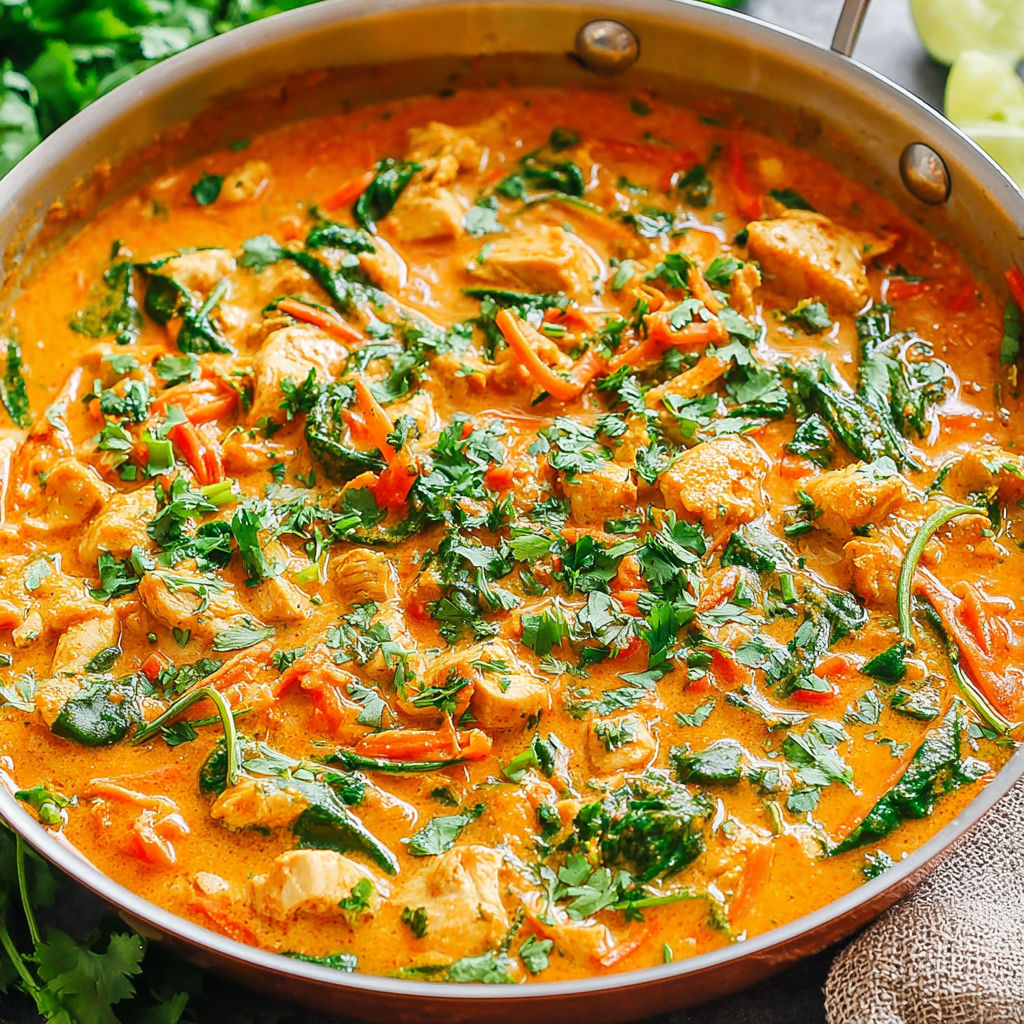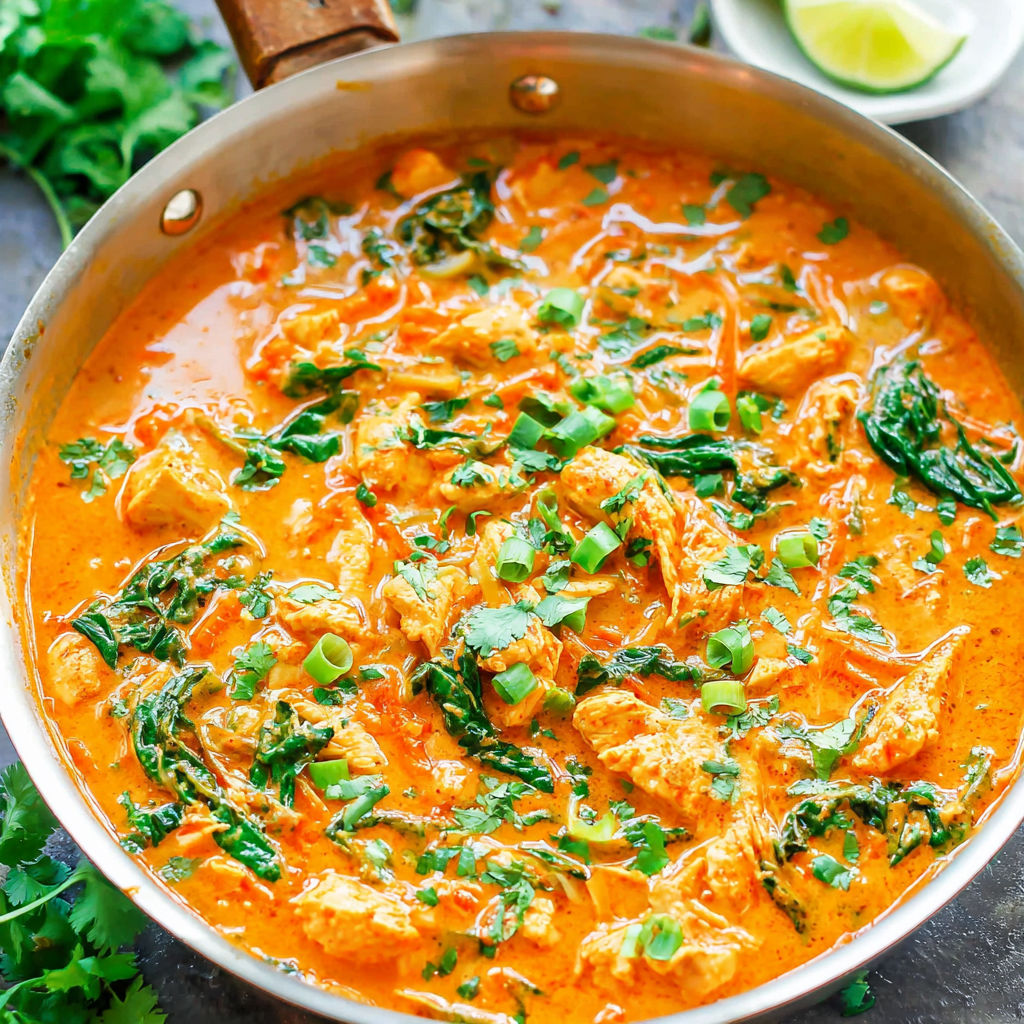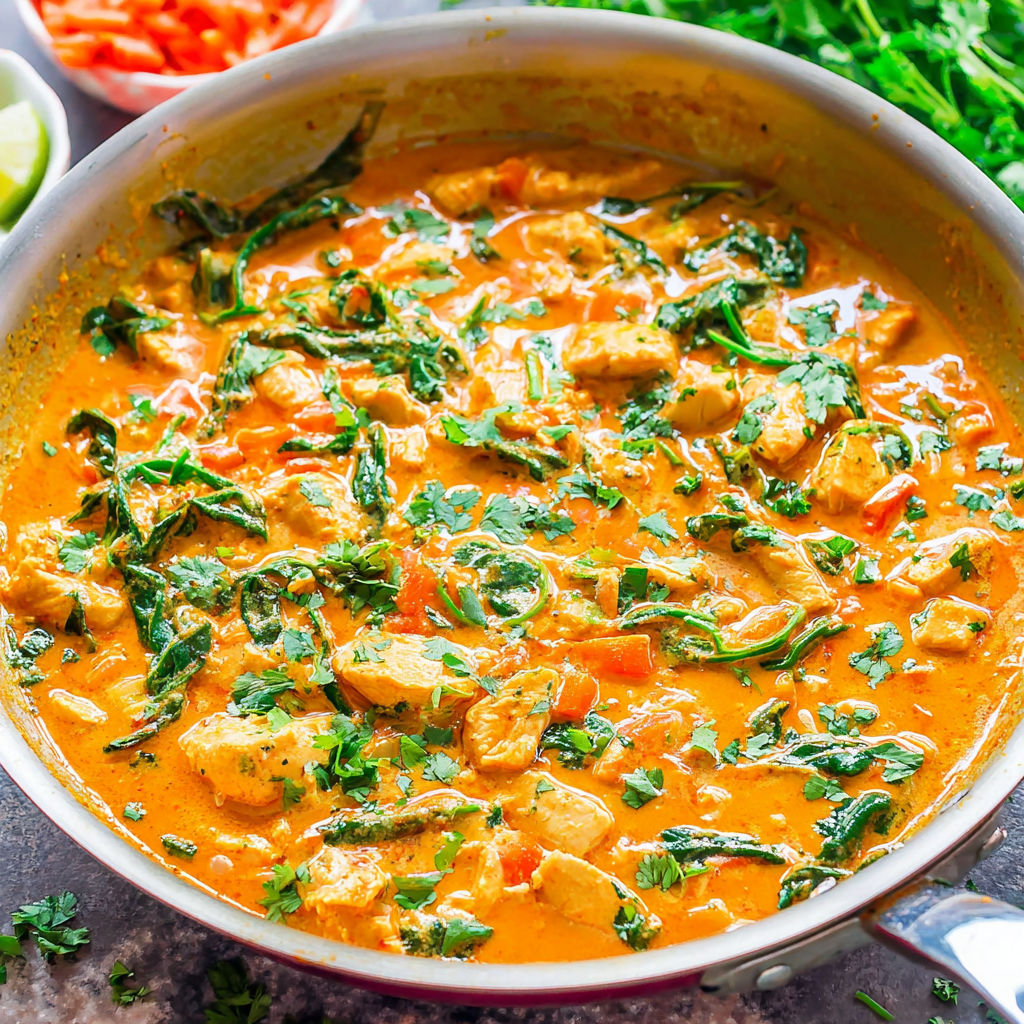 Highlight
Highlight
This Thai Chicken Coconut Curry is an easy one-skillet meal that brings together comforting flavors with healthy ingredients. Ready in just 20 minutes, it’s low in carbs and calories but rich in aroma and warmth, perfect for a quick weeknight dinner or a cozy meal to share.
I first made this during a busy week and was amazed at how quickly it came together while tasting like something I’d spent hours preparing. Now it’s a go-to when I want flavor without fuss.
Gather Your Ingredients
- Coconut oil: adds a subtle tropical richness and helps bring out the spices make sure to use virgin or cold-pressed for best flavor
- Sweet Vidalia or yellow onion: provides a gentle sweetness and depth choose firm onions without sprouting
- Boneless skinless chicken breast: lean protein that cooks quickly and soaks up the curry flavors look for fresh or thawed pieces evenly sized
- Fresh garlic: boosts aromatic intensity freshly minced or pressed is best for that pungent bite
- Ground or fresh ginger: adds a warm, slightly spicy note fresh grated ginger packs more punch, dried is convenient
- Ground coriander: lends citrusy and earthy notes to balance the richness
- Coconut milk: the base of the curry sauce lite coconut milk keeps it lighter while full-fat gives a creamier texture
- Shredded carrots: add texture and natural sweetness fresh, crisp carrots give the best contrast
- Thai red curry paste: the key flavor driver use as much as you like depending on your spice tolerance
- Kosher salt and freshly ground black pepper: essential seasonings to enhance and balance flavors
- Fresh spinach leaves: provide color, nutrients, and a mild earthy flavor wash thoroughly before adding
- Lime juice: adds brightness and acidity that lifts all the flavors
- Brown sugar: optional touch of sweetness to round out the spice and acidity
- Fresh cilantro: fresh herbaceous garnish that adds freshness basil makes a good alternative
- Rice, quinoa, or naan: suggested accompaniments for a complete meal choose based on personal preference
How to Make It
- Sauté the Onions:
- To a large skillet, add the coconut oil and diced onion. Cook over medium-high heat for about 5 minutes while stirring occasionally. The onions should soften and become translucent, which forms the flavorful base of the curry.
- Cook the Chicken:
- Add the bite-sized chicken pieces to the skillet. Cook for 5 minutes, flipping and stirring often to ensure even cooking until the chicken is no longer pink inside and begins to brown slightly.
- Add the Aromatics:
- Stir in the minced garlic, ground or fresh ginger, and ground coriander. Cook for about 1 minute until the mixture is fragrant. Stir frequently to prevent burning and to release the essential oils from the spices.
- Combine the Sauce Ingredients:
- Pour in the coconut milk then add the shredded carrots, Thai red curry paste, salt, and black pepper. Stir well to incorporate everything evenly. Reduce heat to medium and gently simmer for about 5 minutes or until the sauce thickens slightly and reduces to your desired consistency.
- Finish with Greens and Brightness:
- Add fresh spinach leaves and lime juice. Stir to combine and cook until the spinach wilts, about 1 to 2 minutes. Taste the curry and, if desired, adjust the seasoning by adding brown sugar, extra curry paste, salt, or pepper.
- Garnish and Serve:
- Sprinkle the finely chopped fresh cilantro over the top just before serving. This curry is best enjoyed warm and fresh. Serve alongside rice, quinoa, or naan for a complete meal. Refrigerate leftovers in an airtight container for up to one week.

My favorite ingredient here is definitely the Thai red curry paste because it provides complex flavor layers with a good balance of heat and aromatic spices. I remember making this for a family dinner once and the whole table was thrilled by how restaurant-quality it tasted despite only using one skillet and basic ingredients.
Flavor Boosters
Serving Suggestions Serve over jasmine rice for a traditional touch or with quinoa to keep it lighter and higher in protein. Naan bread is perfect for scooping up the sauce and adds a comforting starch. Garnish with extra fresh herbs or a dollop of plain yogurt for creaminess and balance.
Serving Suggestions
Cultural Context Thai coconut curry is a signature dish in Thai cuisine, reflecting the balance of spicy, sweet, sour, and salty flavors. The use of coconut milk and curry paste highlights regional ingredients common in Southeast Asia. This dish showcases how a few staple ingredients can create complex, layered flavors.
Creative Twists
Seasonal Adaptations Add more crunchy vegetables like bell peppers or snap peas in spring and summer for freshness. In autumn and winter, try adding sweet potatoes or butternut squash to enhance heartiness and warmth. Adjust the amount of red curry paste to either cool things down or dial up the spice depending on the season and personal taste.

This Thai Chicken Coconut Curry is a flavorful, healthy meal that adapts well to many taste preferences. Perfect for busy nights when you want something satisfying and aromatic without the fuss.
Common Questions About the Recipe
- → Can I use chicken thighs instead of breast?
Yes, boneless skinless chicken thighs work well and add extra juiciness and flavor to the dish.
- → What can I substitute for Thai red curry paste?
If you don't have Thai red curry paste, curry powder can be used, though it will give a different flavor profile.
- → Is coconut oil necessary for this dish?
Coconut oil is recommended for its flavor, but olive oil can be used as a substitute without affecting the overall dish drastically.
- → How can I adjust the spice level?
Adjust the amount of Thai red curry paste to taste; reducing it will mellow the heat, while adding more enhances the spice.
- → What is the best way to store leftovers?
Store leftovers in an airtight container in the refrigerator; they will keep fresh for up to one week.
